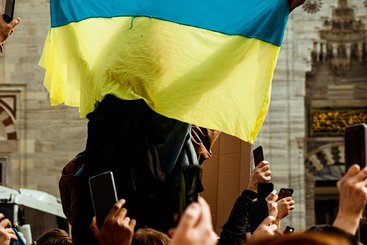In recent years, a critical dialogue has emerged around the role of social media in the politics of protest and resistance, alongside its potential for harm. While much attention has been paid to platforms like Facebook, Instagram and Twitter and their use in the Global North, the range of social media platforms used globally has been studied far less. Effective social media governance cannot be designed on the basis of the use patterns of some platforms in some settings alone. Instead, much better account needs to be taken of the diverse ways that social media platforms intersect with political activity across the world.
Telegram provides an important case for exploring how and why different platforms need to be considered in debates over social media governance. An instant messaging platform founded in 2013 by Russian brothers Pavel and Nikolai Durov and now based in Dubai, it is now used by an estimated 700 million monthly users (significantly more than Twitter’s estimated 450 million).
Like other instant messaging apps, Telegram can be used for one-to-one or group communication. However, what makes Telegram distinct is its use of ‘channels’ – a feed in which a channel’s administrators’ post messages to the subscribers. Blending the public broadcast element of platforms such as Twitter with the perceived privacy of a WhatsApp group, Telegram channels have become increasingly popular media outlets in countries such as Russia, Belarus and Iran – with the most popular channels attracting millions of subscribers. However, perhaps in part because of its relative obscurity in the English-speaking world, Telegram has received far less attention than its rivals from both researchers and media.
A platform for independent media
In those countries where Telegram is most widely used – most of which are authoritarian or score poorly on democratic indicators – it has become a key platform for independent media. Its perceived security, the ability to easily reach large audiences and low levels of regulation have attracted independent media actors barred from traditional media channels.
In Russia, after unsuccessful attempts to block the app in 2018, Telegram is now one of few unblocked social media platforms. Telegram channels of independent news outlets such as Meduza and TV Rain have attracted significantly more subscribers in Russia since 24 February – Meduza tripled its following from 400,000 to 1.2 million, while TV Rain has grown from 200,000 to almost 500,000. Prominent independent media figures such as Yurii Dud (1 million subscribers) and Ekaterina Shulmann (460,000 subscribers) also use the platform to publish their work.
Beyond independent media, anti-authoritarian activists have used Telegram broadcast channels to organise and grow protest movements. In Belarus in 2020, Telegram played a crucial role in protests against Alexander Lukashenko’s fraudulent re-election. The most prominent opposition channel – NEXTA Live – grew from having a few hundred thousand to over 2 million subscribers in the weeks immediately following the election. Similarly, in Iran, Telegram remains popular despite being blocked since 2018, when it was estimated to be used by around half of Iran’s population of 80 million. In the ongoing anti-regime protests, posts by opposition Telegram channels such as BBC Persian (810,000 subscribers) and UK-based Iran International (485,000 subscribers) regularly receive over 100,000 views despite widespread internet shutdowns.
A refuge for extremists
Yet, the conditions and features of Telegram that facilitate its use by independent media and protest movements do not preclude its use by state propaganda outlets. These too benefit from Telegram’s light-touch approach to moderation. One study found that, since the beginning of Russia’s full-scale invasion of Ukraine, pro-Kremlin Telegram channels have attracted more subscribers than opposition channels. State propaganda outlet RIA Novosti has 2.4 million subscribers, while the (admittedly increasingly politically irrelevant) former President Dmitrii Medvedev has 827,000. Telegram is also widely used by popular pro-regime ‘war correspondents’, although these have become a source of vociferous criticism of the Russian military leadership following the Ukrainian army’s recent advances.
Telegram has also become increasingly attractive to some extremist groups. Following the 6 January insurrection in the United States and heightened content moderation, far right actors have migrated away from ‘mainstream’ platforms, leading Telegram to occupy an increasingly central place in the far-right media ecosystem. Similarly, jihadist groups have increasingly incorporated Telegram into their social media ecosystems, using it to cross-post and amplify content from other platforms such as Twitter, Facebook and TikTok.
Telegram’s design, ‘part encrypted messaging app, part social media platform’, makes it suited to navigating protest movements on and offline. However, it also makes it ideally suited to ‘doxing’ – the publication online of individuals’ personal information, often accompanied by an incitement to violence. In situations as diverse as Myanmar and Iraq, Telegram has been used to threaten and intimidate activists and journalists, with allegedly minimal effort to remove content by Telegram. These uses of Telegram for harm sit uncomfortably alongside its role as a space for independent media and anti-authoritarian protests.
Security concerns and state surveillance
Although Telegram promotes itself as anti-censorship – and, indeed, has actively circumvented state blocking of the platform – there are nevertheless numerous concerns about its security. While ‘secret chats’ have end-to-end encryption, ordinary conversations, broadcast channels and group chats do not. In these instances, user-to-server encryption combined with the distribution of servers provides some protection – or at least makes it more difficult to access users’ messages – although content is still stored on Telegram servers as opposed to individual devices. This centralised storage of data contributes to the potential for hackers or legal authorities with which Telegram shares data to access users’ messages.
Further, Telegram’s reluctance to regulate violent, harmful or illegal content has made Telegram an invaluable open-source intelligence resource for repressive states and independent journalists alike. Thus, while it was essential to Bellingcat’s exposure of the identities’ of Russian opposition leader Alexei Navalny’s attempted assassins in December 2020, Telegram has also been used by Russian security services to monitor opposition, as admitted by Vladimir Putin’s spokesman, Dmitrii Peskov in 2017. In Iran, activists have identified government-linked Telegram channels which they say are being used to identify and intimidate protestors.
Implications for global social media governance
Telegram’s use globally, particularly in contexts where democratic rights are contested or precarious, brings a distinct set of considerations and trade-offs for discussions about platform governance. Debates over how to govern and regulate social media platforms have been framed by competing concerns: freedom of expression vs. freedom from harm, protecting privacy vs. promoting wellbeing. In democratic countries, these debates are giving way to legislation on online safety and platform standards. However, as the use of Telegram reveals, much more needs to be done to identify what is required to protect human rights on social media globally, across different platforms and contexts.
In countries where Telegram is popular, the stakes around its use are high. Those same features that are weaponised by state propaganda are an important lifeline for independent media and activists in repressive contexts. These stakes indicate that potential conclusions about appropriate trade-offs between benefit and harm through social media use could look quite different depending on the political conditions in which they are used.
There is clearly not one, and indeed no easy answer to how to approach governance of social media platforms in ways that promote democracy and human rights – or about who (which set of actors or institutions) is best placed to do so. What is clear is that any answer needs to contend with the multiple possible uses of diverse social media platforms across the political contexts in which they operate. More empirically grounded and localised approaches to determining the harms and benefits of social media platform design will be essential to creating a more just, democratic and globally beneficial online space.




